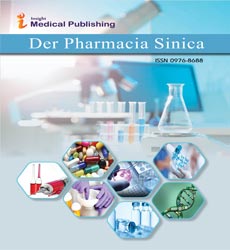ISSN : 0976 - 8688
Der Pharmacia Sinica
In Silico drug designing using tools of bioinformatics
Mohd Hassan Baig*
School of Biotechnology, Yeungnam University, Gyeongsan, Republic of Korea
- *Corresponding Author:
- Mohd Hassan Baig
School of Biotechnology, Yeungnam University, Gyeongsan, Republic of Korea
E-mail: mhassan@hotmail.com
Received Date: September 03, 2021; Accepted Date: September 16, 2021; Published Date: September 23, 2021
Citation: Baig MH (2021) In Silico Drug Designing Using Tools of Bioinformatics. Der Pharmacia Sinica, Vol.12 No.5: 15.
Perspective
“In Silico” means “performed on computer or via simulation.” In Silico drug designing is thus the identification of the drug target molecule by employing bioinformatics tools. The inventive process of finding new medications based on the knowledge of a biological target is named as drug designing. It is often accomplished in two ways:
Structure-based drug design
Relies on knowledge of the three-dimensional structure of the biological target obtained through methods like homology modeling, NMR spectroscopy, and X-ray crystallography etc. Drug discovery process may be a critical issue within the pharmaceutical industry since it's a really costly and timeconsuming process to provide new drug potentials and enlarge the scope of diseases incurred. Both methods of designing drugs, computers and various bioinformatics tool are handy. Thus, in silicon drug designing today is extremely crucial means to allay the arduous task of manual and experimental designing of medication. In silicon technology alone, however, cannot guarantee the identification of latest, safe and effective lead compound but more realistically future success depends on the right integration of latest promising technologies with the experience and methods of classical medicinal chemistry.
The process of drug designing
The drug discovery process involves the identification of the lead structure followed by the synthesis of its analogs, their screening to induce candidate molecules for drug development. Within the traditional drug discovery process, the steps include: Identification of the appropriate drug target which are biomolecules mainly including DNA, RNA and proteins (such as receptors, transporters, enzymes and ion channels). Validation of such targets is important to exhibit a sufficient level of ‘confidence’ and to understand their pharmacological relevance to the disease under investigation. This will be performed from very basic levels like cellular, molecular levels to the entire animal level. Identification of effective compounds like inhibitors, modulators or antagonists for such target is named lead identification where the design and development of an appropriate assay is completed to watch the effect on the target under study. Compounds showing dose-dependent target modulation in terms of a definite degree of confidence are processed further as lead compounds. Subsequently, the experiments are performed on the animal models within the laboratories and therefore the positive results are then optimized in terms of potency and selectivity. Assessing of the physicochemical properties, pharmacokinetic and safety features also are assessed before they become candidates for drug development.
In silico drug design represents computational methods and resources that are wont to facilitate the opportunities for future drug lead discovery. The explosion of bioinformatics, cheminformatics, genomics, proteomics, and structural information has provided many new targets also as new ligands. Bioinformatics techniques hold tons of prospective in target identification (generally proteins/enzymes), target validation, understanding the protein, evolution and phylogeny and protein modeling. Bioinformatics analysis can't only accelerate drug target identification and drug candidate screening and refinement, but also facilitate characterization of side effects and predict drug resistance. One among the main thrusts of current bioinformatics approaches is that the prediction and identification of biologically active candidates, and mining and storage of related information. It also provides strategies and algorithm to predict new drug targets and to store and manage available drug target information.
In molecular docking
Docking is an automatic computer algorithm that attempts to seek out the simplest matching between two molecules which may be a computational determination of binding affinity between molecules. This includes determining the orientation of the compound, its conformational geometry, and therefore the scoring. The scoring could also be a binding energy, free energy, or a qualitative numerical measure. Every docking algorithm automatically tries to place the compound in many various orientations and conformations within the site, then computes a score for every. Some bioinformatics programs store the info for all of the tested orientations, but most only keep variety of these with the simplest scores. Docking are often done using bioinformatics tools which are ready to search a database containing molecular structures and retrieve the molecules which will interact with the query structure. It also aids within the buildup chemical and biological information databases about ligands and targets/proteins to spot and optimize novel drugs. it's involved in devising in silico filters to calculate drug likeness or pharmacokinetic properties for the chemical compounds before screening to enable early detection of the compounds which are more likely to fail in clinical stages and further to reinforce detection of promising entities. Bioinformatics tools help within the identification of homologs of functional proteins like motif, protein families or domains. It helps within the identification of targets by cross species examination by the utilization of pairwise or multiple alignments. The tools help within the visualization of molecular models. It allows identifying drug candidates from an outsized collection of compound libraries by means of virtual high-throughput screening (VHTS). Homology modeling is extensively used for site prediction of candidate drugs.
Open Access Journals
- Aquaculture & Veterinary Science
- Chemistry & Chemical Sciences
- Clinical Sciences
- Engineering
- General Science
- Genetics & Molecular Biology
- Health Care & Nursing
- Immunology & Microbiology
- Materials Science
- Mathematics & Physics
- Medical Sciences
- Neurology & Psychiatry
- Oncology & Cancer Science
- Pharmaceutical Sciences
